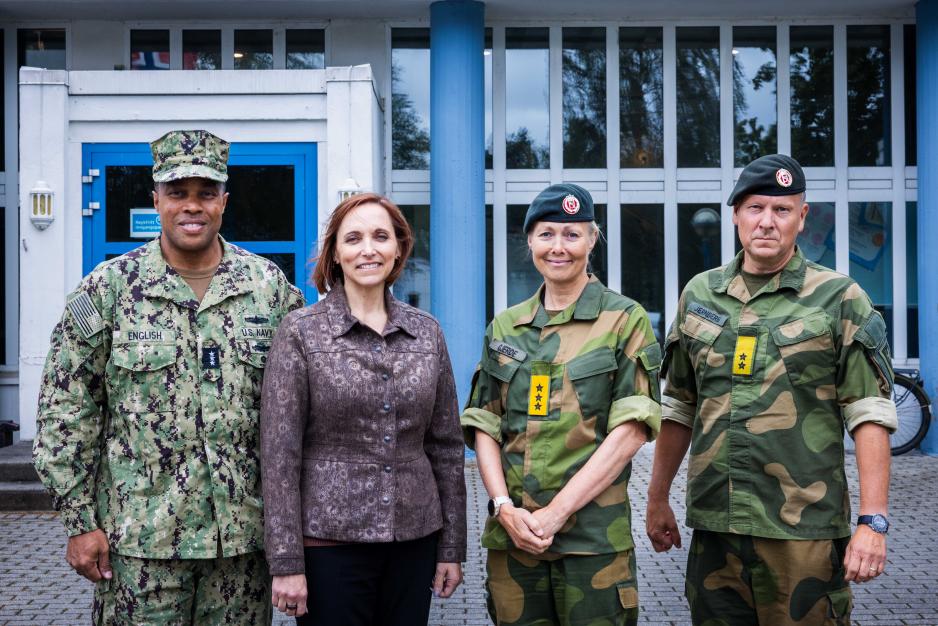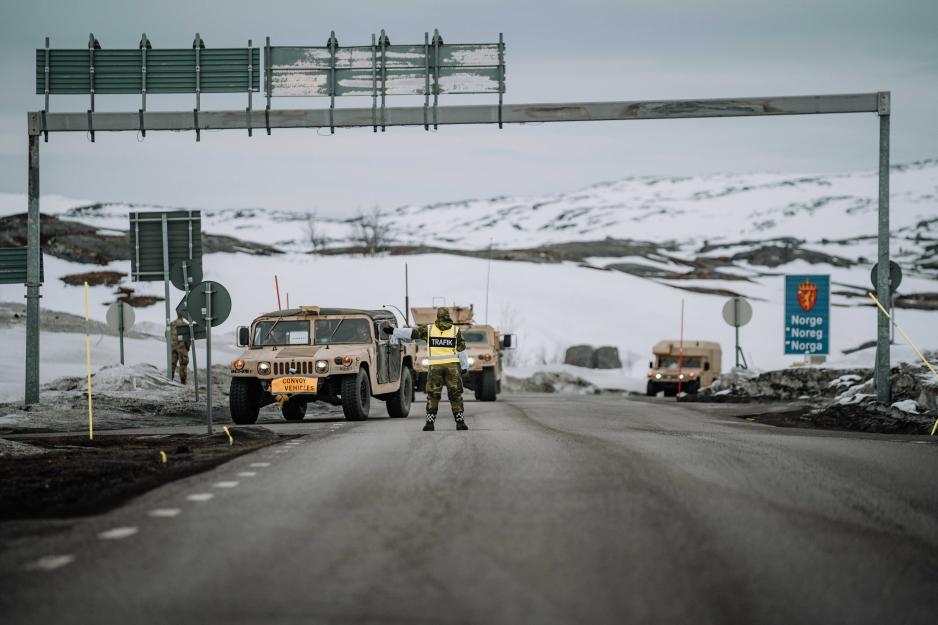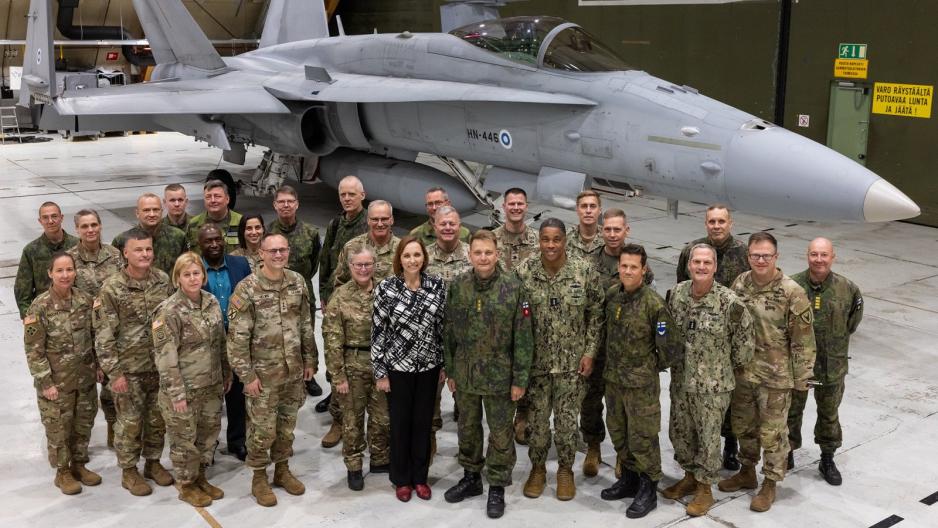US Military Logistics Leadership Visited the Northern Nordic Region

Director of Logistics in the US Joint Staff, Vice Admiral Dion D. English, and Leigh Method, Deputy Assistant Secretary of Defense for Logistics, led the US delegation of logistics leaders visiting the northern Nordic region. Here they are in Norway together with the Chief of the Norwegian Defense Staff, Lt. General Ingrid Gjerde, and the Commander of the Norwegian Defense Logistics Organisation, Major General Anders Jernberg. (Photo: Johannes Bærhaugen / the Norwegian Armed Forces)
Norway, Sweden, and Finland recently welcomed the US Armed Forces logistics leadership for meetings focused on the High North. "We discussed which areas are central in logistics planning for conducting operations in the North," says the deputy commander of the Norwegian Defense Logistical Organisation.
Earlier in August, the US Armed Forces logistics leadership visited Norway, Sweden and Finland to gain a deeper understanding of the region in regard to geography, logistics and host country support.
Logistics planning for operations in the northern parts of the three countries was an overarching focus for the tour, says the Deputy Commander of the Norwegian Defense Logistical Organisation, Brigadier Morten Line Anderssen, to High North News.

Deputy Commander of the Norwegian Defense Logistical Organisation, Brigadier Morten Line Anderssen. (Photo: Torgeir Haugaard / the Norwegian Armed Forces)
"The High North was largely the running theme of the visit. We discussed transport axes from west to south, and which areas could be suitable for prestockage of materiel and which are otherwise central in the logistics planning to conduct operations in the North," says Anderssen.
According to him, the US military logistics leadership annually conduct a tour to one of their operational areas to get a better understanding of it. 15 years have passed since the last visit of this kind was made to the northern Nordic region.
"From the Norwegian side, we spent a lot of time making them more familiar with Norway's role as a frontline state toward Russia, and as a transit area for US and other allied forces into Sweden, Finland, and the Baltic states, providing them with insight into the Nordic military logistics cooperation.
Possibilities for American investments
Norway, Sweden and Finland all have new agreements with the US on bilateral defense cooperation (DCA), which naturally functioned as an important framework for the American delegation's tour.
The US-Norway Supplementary Defense Cooperation Agreement (SDCA) was updated to include additional agreed areas in June 2024. The agreement provides US forces with unimpeded access to and use of a total of 12 military areas on Norwegian soil.
Six of these are in Northern Norway: Andøya, Evenes and Bardufoss air stations, Setermoen garrison (including the firing and exercise range), Ramsund Naval Base, and the Osmarka mountain facility in Evenes municipality.
Was there any talk of possible American investments in infrastructure in the North?
"In our dialogue about the SDCA, we used what is happening at Rygge Air Station as an illustration of how far this cooperation has come and what opportunities exist. Furthermore, we discussed opportunities in all the agreed areas encompassed by the agreement," replies Anderssen.
The US invests about NOK 2 billion in the construction of facilities for the reception of US fighters at Rygge Air Station, Southern Norway. The construction is scheduled to be completed by the end of 2027, and the infrastructure will be Norway's property with the right of use for US forces.
Concerned with stability
The visit to Norway largely took place in the Oslo region, where the American logistics leadership also gained insight into the Norwegian Armed Forces' cooperation with the defense industry.
What feedback did the American delegation give?
"They emphasized the US and Norway's long-term cooperation, and that Norway has been a stable and strong partner since the establishment of NATO. They also referred to the need to strengthen NATO in the High North, and what they could do to contribute to deterrence of Russia and reassurance for the population in the region," says Andreassen, and continues:
"In all, they were very pleased with the insight gained through the visit and maintained that we have joint interests in and joint responsibility for contributing to preserving the stability in the High North."
So the Americans are also concerned with preventing increased tension when new measures are to be taken?
"Yes, that is correct. We must think differently about logistics and support of exercises and training in the High North, particularly because of Finland as a new NATO member. Focusing on stability in the region is a natural part of the discussion. In other words, we make sure the measures we implement work as intended, not making conditions more difficult or tense," he responds.

Host country support at the Cap of the North was a focus under the Immediate Response 2024 exercise. US forces and their materiel were received in Narvik, Northern Norway, before moving to Finland via Sweden by train and road. Here, US military land vehicles are crossing the border into Sweden. (Photo: David Kristiansen / the Swedish Armed Forces)
Strategic significance
After the stay in Norway, the US delegation visited Kiruna in Northern Sweden, connected to the Port of Narvik in Northern Norway through the Ofoten/Iron Ore Line. Among other places, they visited the mining company LKAB visitor's mine.
"We have explained how we fulfill our role as a transit country and logistical hub within NATO in Northern Europe, and how this enables rapid reception and support of allied forces," says Major General Stefan Sandborg, head of the Swedish Defense Staff’s Support Division.
According to the Swedish Armed Forces, the visit was about highlighting Sweden's regional prerequisites for host country support and its total defense perspective, as well as the cooperation between the Nordic countries.
The implementation of the DCA between Sweden and the US, which entered into force in August 2024, was also discussed. The focus was on the opportunities the agreement provides for supporting the deployment of forces and infrastructure for transport, supplies, and prestockage.
There are 17 agreed areas in Sweden, four of which are in the North. The Kiruna military camp and training area are among these.
"The visit clearly shows the strategic significance of the Cap of the North in today's security policy situation. Through the visit, we also take an important step in developing and deepening the US and Sweden's military cooperation in a practical and concrete way," states Peter Sandwall, State Secretary in the Swedish Ministry of Defense.

The American delegation visiting Northern Finland. (Photo: Finnish Defense Forces)
Briefing on Northern Finnish conditions
Furthermore, the American logistics leadership went to Rovaniemi in Northern Finland, where the visit also revolved around deepening the bilateral defense cooperation regarding logistical cooperation.
The DCA between Finland and the US entered into force in September last year, and covers a total of 15 agreed areas, five of which are in the North. Rovaniemi Air Base is among them.
The delegation was introduced to the specific features of Finland’s logistics system in the North, as well as the country’s northern operational area and Finnish winter equipment, according to the Finnish Defense Forces.
"The defense cooperation between Finland and the United States keeps deepening constantly also in the field of logistics. Logistics has to be fluent and compatible, otherwise the big picture won’t work. The northern circumstances, the cold and long winters, for example, pose their special requirements on know-how and solutions," says Lieutenant General Jari Mikkonen, Deputy Chief of Staff Logistics and Armaments in the Finnish Defense Forces.
"During the visit, we also examined the areas and facilities in joint use as specified in the DCA. Having thorough knowledge of them is essential from the point of view of the fluency of even ordinary, everyday cooperation,” adds Mikkonen.
The Finnish Defense Forces also informs that US forces will participate extensively in training activities in Finland this fall.




